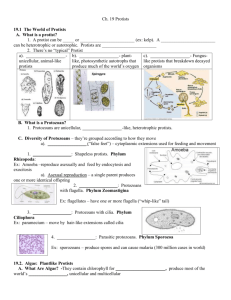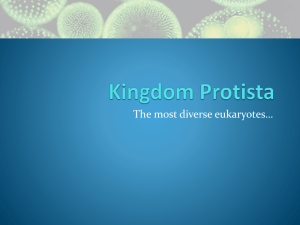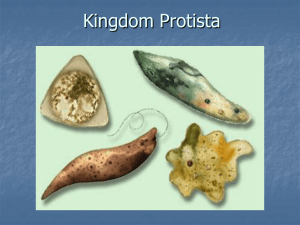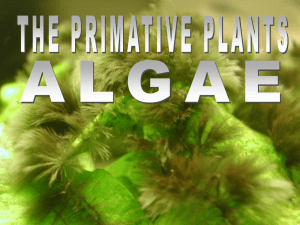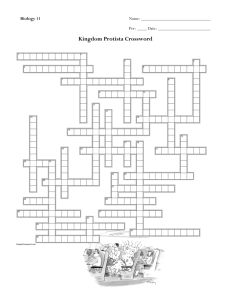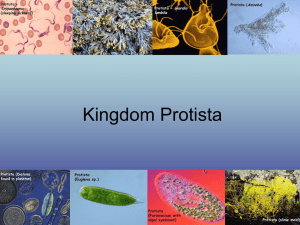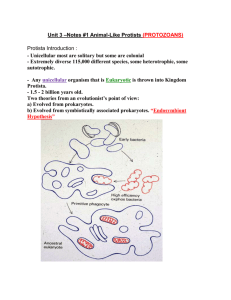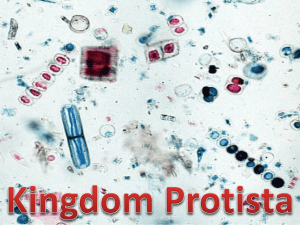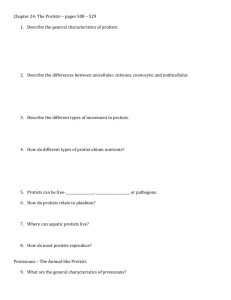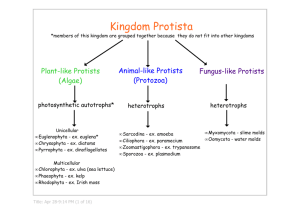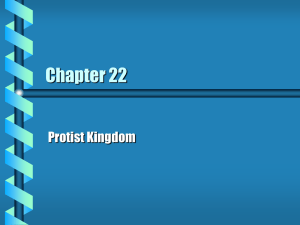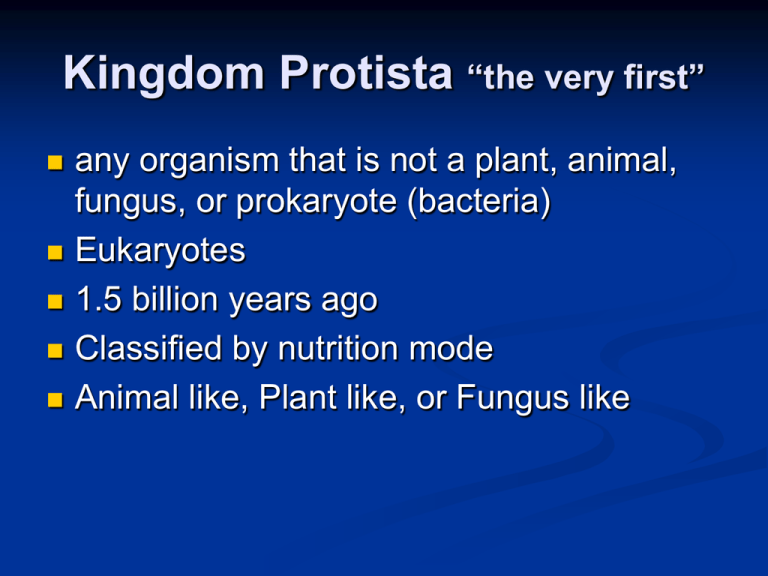
Kingdom Protista “the very first”
any organism that is not a plant, animal,
fungus, or prokaryote (bacteria)
Eukaryotes
1.5 billion years ago
Classified by nutrition mode
Animal like, Plant like, or Fungus like
A) Animal-like Protists:
Protozoans
Protozoa-”First
animals”
Heterotrophs
Four phyla based
on how they move
1) Phylum Zoomastiginia: Zooflagellates
flagella
Absorb food through
their cell membranes
Most reproduce
asexually- binary
fission
Live in lakes and
streams or bodies of
other organisms
Diseases
African sleeping sickness
Trypanosoma – Tsetse Fly
Chills, rashes, nerve cell damage, coma
Trichomonas vaginalis – vaginitis
Termites and Trichonympha
Symbiotic (lives off food from termite)
Lives in termite gut
Contains cellulase that digests wood
2) Phylum Sarcondina:
Sarcodines
Pseudopods “false foot” – cytoplasmic projections for
eating and movement
Best known sarcodine - Amoeba
Amoeboid movement
Contractile and Food Vacuoles
Binary Fission
Foraminiferans – secrete calcium carbonate shells
(chalk), accumulates on bottom of ocean.
ex. AMOEBA
Contractile Vacuole
(pump water)
Pseudopods
Nucleus
Food Vacuole
(store food)
Amebic Dysentery
•Entamoeba-parasite spread by contaminated
drinking water from poor sanitation
•Severe diarrhea, attacks intestines, bleeding
•Boiling water or iodine kills parasite
3) Phylum Ciliophora:
Ciliates
Cilia – used for feeding and movement
Short, hair-like projections
Binary Fission and Conjugation (stress)
Best known ciliate – paramecium
Freshwater and saltwater
Trichocysts-stiff projections for defense of
paramecium
Internal Anatomy
Two nuclei
Macronucleus
respiration, protein synthesis, and digestion.
Micronucleus
conjugation and contains a reserve copy of
genes.
Paramecium
Lysosomes
Trichocysts
Oral groove
Gullet
Anal pore
Contractile vacuole
Micronucleus
(conjugation) Macronucleus
Food vacuoles Cilia
Nutrition
The cilia move food into the oral groove
which leads to the gullet.
The food is forced into food vacuoles
Lysosomes break down the food
Undigested food is removed through the
anus
Contractile Vacuole pumps water in and
out to maintain homeostasis
Conjugation
New
macronuclei
form
Macronucleus
Micronucleus
MEIOSIS
Exchange of
micronuclei
Macronuclei
disintegrate
Genetically
identical
paramecium
form
*note: conjugation is a sexual process but NOT a form of
sexual reproduction b/c no new individuals are formed.
However, new combinations of genetic information are
produced.
4) Phylum Sporozoa:
Sporozoans
Parasitic protists
Parasites of many different organisms,
including worms, fish, birds, and humans.
Many protists cause serious disease
Cannot move independently
Reproduce using sporozoites
A sporozoite can attach itself to a host and
lives as a parasite.
Diseases
Malaria- sporozoan Plasmodium
Saliva of the female Anopheles mosquito
Sporozoites enter the bloodstream and the
plasmodium infects the liver cells and red blood
cells.
Red cells burst and release toxins into the
bloodstream
2 million people die each year from malaria.
B) Plant-like Protists:
Unicellular Algae
Base of the food chain
“phytoplankton”
photosynthetic pigments
4 phyla based on the type of pigments
they contain
1) Phylum Euglenophyta:
Euglenophytes
two flagella
Lack a cell wall
Cell membrane called a pellicle
Chloroplasts – photosynthetic
Heterotrophic if no sunlight available
Eyespot – finds sunlight
Pellicle – tough and flexible
Euglena
Chloroplast
Carbohydrate
storage bodies
Gullet
Pellicle
Flagella
Eyespot
Nucleus
Contractile
vacuole
2) Phylum Pyrrophyta “fire
plants”: Dinoflagellates
50% photosynthetic
50% heterotrophs
2 flagella
Plates made of
cellulose for
protection
Many are
bioluminescent
http://www.ted.com/talks/view/id/206
Zooxanthellae (ex. of
dinoflagellates)
Photosynthetic dinos that provide food for
their host organism.
The host provides carbon dioxide and
shelter.
Examples of host organisms: jellyfish,
coral, clams
Red Tide
Water appears red
due to “Algal
Bloom”
Some dino species
will release a toxin
that effects the
nervous systems of
fish
Ban on shellfish
Paralytic Shellfish Poisoning
PSP is caused by a dino species that
produces a toxin that is taken up by
mollusks.
Eating these infected shellfish can cause
serious illness, paralysis, or death
Pfiesteria-dinoflagellates
(blooms triggered
by pollution)-parasiteslesions
3) Phylum Chrysophyta:
Chrysophytes
Yellow-green and golden-brown algae
Gold-colored chloroplasts
Pectin cell wall
Store food in the form of oil
4) Phylum Bacillariophyta:
Diatoms
Cell walls – silicon
(glass)
Cannot
decompose
C) Plantlike Protists:
Multicellular
Algae
Red, Brown, and Green
1) Phylum Rhodophyta:
Red Algae
Contain Chlorophyll a and Phycobilins
Absorb blue light – 260 meters, very deep
Important role in forming coral reefs
Chondrus crispus- Irish moss
Chondrus crispus – Irish Moss
2) Phylum Phaeophyta:
Brown Algae
Chlorophyll a and c, Fucoxanthin
Holdfast, Stipe, Blades, Bladders
Fucus- Rockweed
Sargassum
Kelp
Kelp
Kelp
Rockweed
Fucus : Rockweed
Sargassum
Blade
Stipe
Hold Fast
3) Phylum Chlorophyta:
Green Algae
Cellulose in their cell walls
Chlorophyll a & b
Stores food as starch
Very similar to plants
Unicellular Green Algae
Chlamydomonas
Lives in ponds, wet
soil, etc.
Colonial Green Algae
Spirogyra
Volvox – connected strands of cytoplasm,
coordinated flagella movement
Multicellular Green Algae
Sea lettuce- Ulva
Importance of Algae
•Base of the food chain
•Kelp forests – habitats
•50% of oxygen production
•Medical Use
•Ulcers, High Blood Pressure,
arthritis

